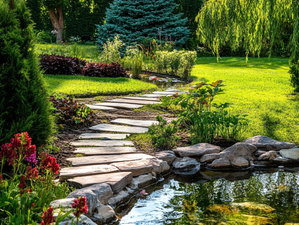Posted by Backyard Supplies on Jan 29th 2014
How to Create an Eco-Friendly Backyard Oasis.
Transforming your backyard into an eco-friendly oasis isn’t just good for the planet, it is a chance to reconnect with nature and create a peaceful retreat right outside your door. With a few thoughtful changes, you can design a sustainable space that supports local ecosystems, conserves resources, and invites relaxation. Here’s how to get started:
1. Choose Native Plants
Native plants are the backbone of an eco-friendly yard. They’re adapted to your region’s climate, requiring less water, fertilizer, and pesticides than non-native species. Plus, they provide food and shelter for pollinators like bees, butterflies, and birds. Research local nurseries or consult gardening apps to find plants that thrive in your area.
2. Harvest Rainwater
Install a rain barrel to collect runoff from your roof. This free water source can irrigate your garden during dry spells, reducing your reliance on municipal water. Pair it with a drip irrigation system to deliver water directly to plant roots, minimizing waste.
3. Create Wildlife Habitats
Invite biodiversity by adding features like bird feeders, bee hotels, or a small pond. Even a shallow dish of water can attract pollinators. Avoid chemical pesticides and opt for natural pest control methods, like introducing ladybugs or planting marigolds to deter pests.
4. Go Solar
Light up your evenings with solar-powered string lights or pathway lamps. Solar energy cuts electricity use and adds a warm ambiance. For a bigger impact, consider solar-powered water features like fountains or birdbaths.
5. Use Sustainable Materials
When building decks, patios, or garden beds, choose reclaimed wood, recycled composite materials, or natural stone. Avoid pressure-treated lumber, which can leach harmful chemicals. For furniture, look for pieces made from bamboo, recycled metal, or FSC-certified wood.
6. Compost & Mulch
Turn kitchen scraps and yard waste into nutrient-rich compost to feed your soil naturally. Spread mulch around plants to retain moisture, suppress weeds, and regulate soil temperature. Both practices reduce landfill waste and eliminate the need for synthetic fertilizers.
7. Design for Shade & Cooling
Plant trees strategically to shade your home and outdoor seating areas, lowering energy costs in summer. Deciduous trees (which lose leaves in winter) provide shade in summer and sunlight in winter. Add climbing vines on trellises for natural, living shade screens.
8. Embrace Imperfection
An eco-friendly yard doesn’t need to look manicured. Let fallen leaves decompose to nourish the soil, leave some “wild” corners for critters, and allow clover or native grasses to grow in place of traditional lawns.
Creating an eco-friendly backyard oasis is about working with nature, not against it. Small changes add up, and even a modest yard can become a haven for wildlife, a carbon sink, and a personal sanctuary. Whether you’re sipping morning coffee under a solar-lit pergola or watching fireflies dance over your wildflower garden, you’ll enjoy the rewards of a space that’s as kind to the Earth as it is to your soul.
Ready to start? Grab a shovel, pick your first native plant, and let your backyard transformation begin!

